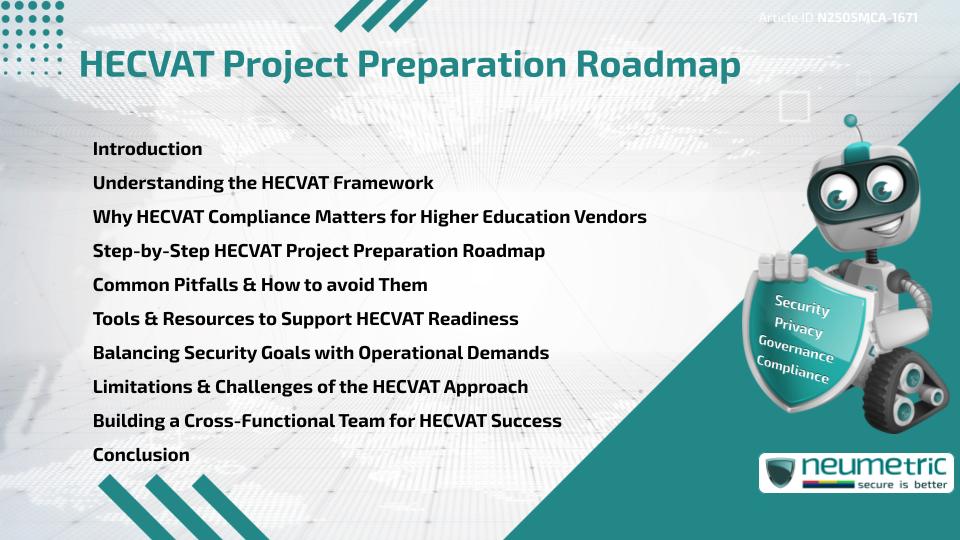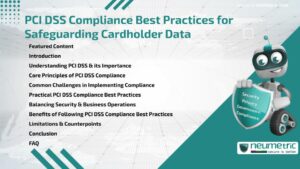Table of Contents
ToggleIntroduction
The HECVAT Project Preparation Roadmap is an essential Guide for Cloud Service Providers & Vendors aiming to do business with colleges & universities. Developed to assess Vendor Risk in higher education, the Higher Education Community Vendor Assessment Toolkit (HECVAT) ensures Third Party services meet Institutional Security Standards.
This article breaks down the HECVAT journey into manageable steps, offering practical advice, historical context & guidance on overcoming common challenges. Whether you are a SaaS Vendor or an Institutional IT leader, understanding the HECVAT project preparation roadmap is key to building Trust & Compliance in educational partnerships.
Understanding the HECVAT Framework
The HECVAT is a Security Assessment Questionnaire meant for the higher education domain. Created by EDUCAUSE & Internet2, it standardises Vendor Risk evaluation & helps Institutions compare solutions on a common Security benchmark.
There are multiple forms of HECVAT depending on the service & data sensitivity:
- HECVAT Full: For high-Risk services handling sensitive Institutional data
- HECVAT Lite: For low-Risk Vendors with minimal data exchange
- HECVAT On-Premise: For locally hosted solutions
- HECVAT Cloud Broker Index: For Institutions managing multiple Vendor relationships
The HECVAT project preparation roadmap helps Vendors align their practices with these expectations.
Why HECVAT Compliance Matters for Higher Education Vendors
Higher Education Institutions are data-rich but often resource-constrained. They rely on external Vendors to deliver scalable services. However, these partnerships must also ensure FERPA, HIPAA & other Compliance safeguards.
Following the HECVAT project preparation roadmap:
- Signals that your Solution meets Institutional Security requirements
- Shortens the procurement review cycle
- Reduces back-and-forth between Vendor & Institution Security teams
- Enhances your reputation among higher ed clients
HECVAT Compliance is no longer optional—it’s a core part of doing business in this space.
Step-by-Step HECVAT Project Preparation Roadmap
A thoughtful HECVAT project preparation roadmap includes the following core steps:
1. Understand the Institution’s Security Requirements
Start by reviewing the Security posture of your prospective Client. Some may require HECVAT Full, while others may accept HECVAT Lite.
2. Assign a Project Owner
Designate someone who understands both technical & business contexts. This person will lead communication with the Institution & coordinate internal data collection.
3. Gather Supporting Documentation
Prepare essential Security Policies such as:
- Incident Response plans
- Data Encryption Standards
- Access Controls
- Privacy Policies
Many Institutions will request this alongside your completed HECVAT form.
4. Complete the HECVAT Questionnaire
Use the official HECVAT tools from EDUCAUSE to fill out the form. Be accurate & transparent—exaggerating controls can lead to trust issues down the line.
5. Review & Validate Internally
Involve Stakeholders across IT, Compliance & Operations to review your responses. This ensures consistency & accuracy.
6. Submit & Track your HECVAT
Send the completed form through the Institution’s requested process.
7. Respond to Clarification Requests
Be ready for feedback. Address gaps or concerns quickly to maintain the momentum of your proposal.
Common Pitfalls & How to avoid Them
Missteps in the HECVAT project preparation roadmap often arise from:
- Incomplete documentation: Security Gaps or missing Policies delay approval
- Lack of internal collaboration: HECVAT requires input from multiple teams
- Overstating capabilities: Always be honest about what Controls are in place
- Using outdated forms: The HECVAT templates are periodically updated—use the latest version
Avoiding these pitfalls helps maintain credibility & speeds up onboarding.
Tools & Resources to Support HECVAT Readiness
Several resources can ease your journey:
- EDUCAUSE HECVAT Library: Official Forms & Guidelines
- CIS Controls: Practical guidance for implementing Controls that align with HECVAT
- NIST CyberSecurity Framework: Used by many Institutions as a Security benchmark
- Cloud Security Alliance: Offers Cloud-focused checklists that align with HECVAT questions
Balancing Security Goals with Operational Demands
Security requirements must align with business realities. The HECVAT project preparation roadmap offers a structure, but Vendors must balance this with:
- Product Development timelines
- Customer Support demands
- Third Party Service dependencies
Making Security a shared value across teams—not just a Compliance task—can bridge this gap.
Limitations & Challenges of the HECVAT Approach
Despite its benefits, the HECVAT approach has limitations:
- It can be time-consuming, especially for small Vendors
- Not all Institutions interpret responses the same way
- Completing multiple versions for different clients may cause fatigue
- Answers may become outdated quickly if Security Controls evolve
Still, the HECVAT project preparation roadmap offers a widely accepted starting point that reduces Institutional Risk.
Building a Cross-Functional Team for HECVAT Success
A successful HECVAT submission isn’t a one-person job. Teams should include:
- Security leads to provide accurate technical responses
- Compliance experts to ensure regulatory alignment
- Product managers to reflect roadmap commitments
- Legal reviewers to confirm Privacy obligations
Conclusion
The HECVAT project preparation roadmap is more than a checklist—it’s a strategic tool that enables Vendors to align with the Risk expectations of higher education Institutions. By following a clear process, engaging the right teams & leveraging trusted resources, Vendors can demonstrate their commitment to Security & transparency.
While the process requires time & collaboration, the payoff is significant: faster onboarding, stronger Institutional trust & long-term Client relationships. The roadmap ensures you are not just answering questions, but building the foundation for successful partnerships in the education sector.
Takeaways
- The HECVAT project preparation roadmap provides a structured path for Vendors to meet higher education Security expectations
- Assign a clear project lead & gather detailed documentation early
- Use official resources & stay updated on form revisions
- Balance transparency with operational efficiency
- Avoid common mistakes such as incomplete or exaggerated responses
FAQ
What is the HECVAT project preparation roadmap?
It’s a step-by-step Guide Vendors use to align with HECVAT requirements & complete the assessment accurately.
Who needs to follow the HECVAT project preparation roadmap?
Any Vendor seeking to provide services to colleges or universities should follow this roadmap.
How long does it take to complete the HECVAT project preparation roadmap?
It varies by Organisation, but most Vendors can complete the process in two (2) to four (4) weeks.
What’s the difference between HECVAT Full & Lite?
HECVAT Full is meant for those who handle Sensitive Data in high-Risk services. Lite is for low-Risk services with minimal data exposure.
Do Institutions always require a HECVAT submission?
Not always, but many do. Institutions may waive it for low-Risk services or internal tools.
Can the same HECVAT be submitted to multiple Institutions?
Yes, but Institutions may ask additional questions or need updated responses over time.
What if our Organisation lacks formal Security Policies?
You should develop basic Policies aligned with the HECVAT requirements before submission.
Is the HECVAT project preparation roadmap suitable for startups?
Yes, especially if they want to establish early trust & credibility with education clients.
References
- HECVAT Toolkit on EDUCAUSE
- CIS Controls List – Center for Internet Security
- FERPA Overview – U.S. Department of Education
- NIST CyberSecurity Framework
Need help?
Neumetric provides organisations the necessary help to achieve their Cybersecurity, Compliance, Governance, Privacy, Certifications & Pentesting goals.
Organisations & Businesses, specifically those which provide SaaS & AI Solutions, usually need a Cybersecurity Partner for meeting & maintaining the ongoing Security & Privacy needs & requirements of their Clients & Customers.
SOC 2, ISO 27001, ISO 42001, NIST, HIPAA, HECVAT, EU GDPR are some of the Frameworks that are served by Fusion – a centralised, automated, AI-enabled SaaS Solution created & managed by Neumetric.
Reach out to us!





